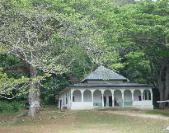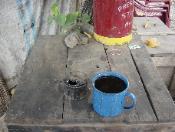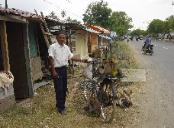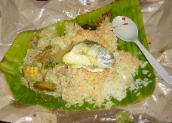
| 3 March 2005 - Eric Azhari, whose name I spelled and pronounced differently a few days ago, is the man interested in restoring the fishing industry in his village Lampuloh. Boats of his village are completely different than the shuttling Keramba system of Krueng Raya. They are larger with a cabin and employ 21 men at a time. His village had eighty before and now has only forty. The rest of the data sadly suggests that Lampuloh needs fishermen more than boats to rebuild its industry. He was outside when the first wave came rolling in. He yelled to his mother and sisters to stop standing there crying and start running and praying. He escaped a fifteen-meter wave by climbing some structure that held while others all around him were being swept away. He said the tsunami rolled out nearly as fast as it came in dragging debris back the other way. He found his brother and father three days later and they drank coconut water to stay alive. Azhari told me he lost fifty goats, which squelches the theory that animals survived using super tsunami sensors in their ankles. He said there were many livestock and wild animals of all sorts killed. I had told Azhari I wanted to go find a mountain and have a nice authentic Acehnese lunch somewhere so this morning we took an hour’s motorcycle ride to the country. We rode through the village of Sibreh on a dirt road that went for a long way deep into the jungle up a steep grade over the saddle between two steep peaks and into the next valley. We’d been riding in a light rain for quite some time and getting way back in there when Azhari told me we probably ought to turn back. It started coming down real hard and I looked into but passed up the opening of a large dry cave and we crouched under a big tree until the rain let up. It was breathtaking scenery full of incredible trees and dense tropical undergrowth. Birds. Back down at the base of the mountain I paused to look at a beautiful country mosque when it began to rain hard again. Soaking wet we ditched into a little thatched-roofed café. I ordered coffee “pet” which means black, no sugar. It came with a spoon and a little swirl of sugar in the bottom. I sent it back and asked for coffee with no sugar and got Nescafe instant. I then told the Pak thanks but I really just wanted a nice cup of traditional Acehnese. He brought me a big cup of boiling water piled high with floating grounds. He reassuringly motioned that a few stirs and it would be ok. Sure enough, the grounds dropped to the bottom and I had one of the purest coffee experiences known to man. ‘Mangat that’ I told him. They all laughed and watched me drink every sip. It has been a bit nerve racking but I am starting to get used to having the entire room stop what they are doing and just stare. Apparently, this is not a rude thing to do here because nobody thinks twice about it or flinches in the least when I stare back at them. They comment to each other about how I might be holding the spoon or the way I sip the coffee. I have had complete strangers sit down at my table apparently just to watch me eat or drink. I mean what are we gonna talk about? We left the roadside coffee shop and rolled back through the streets of Sibreh. Azhari passed up several cafés and settled on one in the heart of the market. Out front in the market was a big table with a thousand big sharp knives laying on it. I asked Azhari what the knives were for. He said for cut. For cut what I asked and he said yes. Many of the folks there smilingly told me they had never seen a white person before. We sat down and they brought us a bowl of rice and a familiar concoction I’ ve had a few times now. It was as authentic Acehnese as you can get and it was damned goot. In fact, our table had as its centerpiece the head. I asked Azhari what exactly should one do with the goat’s head. He said is for eat. For eat what I asked and he said yes. |
Journal Entries
Journal Entries







